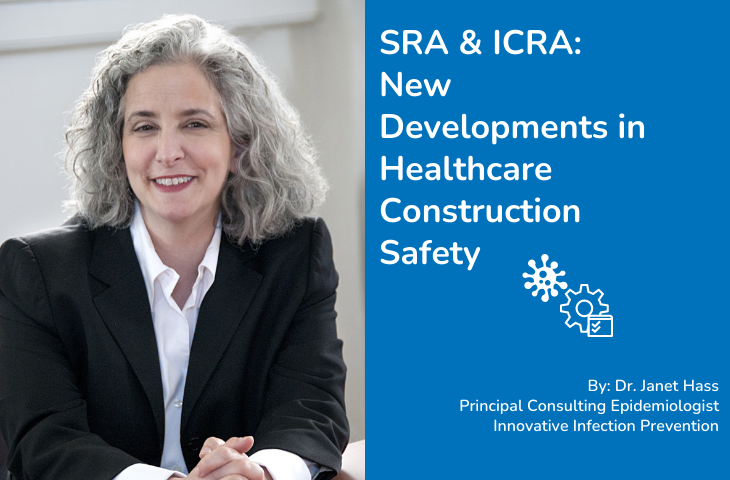
By Janet Haas, Principal Consulting Epidemiologist at Innovative Infection Prevention
We are honored to welcome our infection prevention advisor, Janet Haas, as a guest author to help us understand these healthcare construction safety developments. Dr. Haas is currently Principal Consulting Epidemiologist at Innovative Infection Prevention and an associate editor of the American Journal of Infection Control (AJIC). She previously served as Director of Epidemiology at 3 academic medical centers, and as 2018 APIC President. Prior to beginning her nursing and infection prevention professional journey, Janet also worked as a Journeyman Millwright Mechanic and was a member of the Carpenter’s Union.
If you are like many people, you may be confused about SRAs and ICRAs. Few IPs, FMs, or healthcare contractors have heard of the Safety Risk Assessment or SRA, and most start to think about the Infection Control Risk Assessment or ICRA only in the days before construction begins. However, both should be integral parts of the design and planning phases of construction and renovation projects. Let’s explore both to see their intended functions, how they complement each other, and how best to implement each.
SRA
Let’s start with the Safety Risk Assessment. While both the SRA and ICRA are done before construction begins, the SRA has a broader focus. The SRA is a comprehensive assessment of the functionality of the space as it impacts patient and staff safety. Questions like the following are covered in the SRA – and the results guide the design of the space.
- What types of patients will it serve?
- How many staff members will work there?
- What special equipment will be used?
- What long term plans should be considered that may impact how this space is used in the future?
To illustrate this, think about how these population specific needs impact design:
- Bariatric units: toilets, space and seating will have to be appropriate for larger, heavier people. To keep staff safe, lifting equipment that can handle heavier people, must be widely available.
- Pediatric units: there may be special considerations for family focused areas and play rooms.
- Units housing dementia patients: should be designed so that nurses and aides have visual contact with the patients in order to keep them safe. This may be accomplished with a patient seating area near the nurses’ station, or nurses’ work areas might be spread out among the patient rooms.
A well executed SRA can help provide a safe functional unit, and avoid the need to modify the space once it’s built. It’s important to hear from the people who will use the space, facilities people who will manage the infrastructure, infection prevention and control and others who work to keep patients safe. Having input from everyone helps assure the design will meet the program, safety, life safety and infection prevention needs.
ICRA
The ICRA is used to address infection control in the design AND construction phases. In many facilities, this is done closer to the time of the actual construction, and is focused on maintaining safety during construction. Most infection preventionists, facility managers and healthcare contractors are familiar with the ICRA safety matrix, which guides protective measures during construction based on the scope of work and the proximity to high risk patients or areas (such as the operating room or central sterile processing). If you just use the ICRA matrix as a guide, it’s often performed after the design phase is complete.
It’s important that the infection preventionist is also involved in the planning stages to assure that the functional and safety requirements are met.
The SRA and the ICRA have some overlap, such as in these scenarios:
- Making sure there are an adequate number of handwashing sinks impacts patient safety and infection control.
- Designing ventilation that can change to create floors or buildings with all negative pressure is part of emergency preparedness, safety and infection control.
The earlier the design and containment are discussed, the more transparent the requirements will be. For example, additional storage space requirements for either interim construction use or the clinical unit must be resolved prior to construction start. Or, if special equipment such as HEPA filters or manometers are needed during construction, knowing this in advance will allow enough time to get equipment on site.
After the design and functionality of the space is reviewed, the ICRA safety matrix becomes the focus. The goal of the ICRA safety matrix is to assure that the space is isolated sufficiently to prevent dust from migrating to other areas of the facility during construction. An important thing to remember is that the ICRA itself doesn’t protect anyone. Frequent monitoring throughout the entire project by the project managers, infection prevention and the facility safety team helps assure a safe construction environment. Combining construction safety with a design based on ICRA and SRA will help ensure patient and staff safety during construction and beyond.
